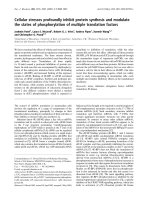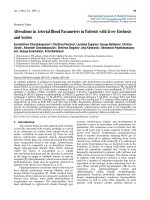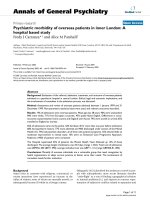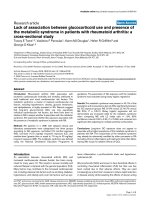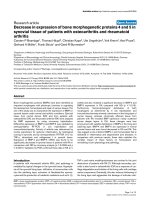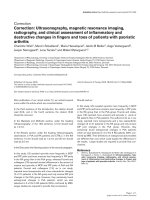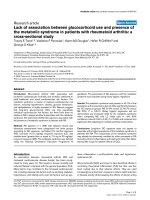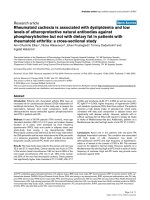Báo cáo y học: "Anaesthesia in septic patients: good preparation and making the right choice" potx
Bạn đang xem bản rút gọn của tài liệu. Xem và tải ngay bản đầy đủ của tài liệu tại đây (39.46 KB, 2 trang )
Available online />Page 1 of 2
(page number not for citation purposes)
Abstract
Septic patients may require anaesthesia for surgery or to facilitate
endotracheal intubation for respiratory failure. These patients
frequently start with a deranged haemodynamic state, including
vasodilation with hypotension, and cardiomyopathy, making induc-
tion of anaesthesia a potentially hazardous task. Anaesthetic
agents are well known to decrease contractility and to cause
vasodilation – in part from direct effect of the drugs, and in part
due to the state of anaesthesia, that causes reduced sympathetic
tone. Before induction, the physician should understand the
haemodynamic state (especially using echocardiography), should
restore cardiovascular reserve with inotropes and vasopressors,
and should induce anaesthesia with the smallest dose of the safest
drug. In the previous issue of Critical Care, Zausig and colleagues
show that propofol may not be the safest choice of induction agent
in septic patients.
Septic patients requiring induction of anaesthesia for surgery
or mechanical ventilation frequently have severe haemo-
dynamic derangement, which is likely to be made worse by
anaesthesia. Anaesthetic drugs are well known to decrease
contractility and to cause vasodilation both from direct effects
on the heart and vasculature, and from the loss of
sympathetic tone induced by the state of anaesthesia. In the
previous issue of Critical Care, Zausig and colleagues
examined the direct effects of intravenous anaesthetic agents
on the myocardium, using an isolated septic rat heart
preparation [1].
Prior to induction of anaesthesia, the physician should attend
to three aspects of care. Firstly, the physician should
understand the underlying haemodynamic state to determine
how bad the myocardial performance is. This is easily
achieved using focused transthoracic echocardiography
[2-4], assessing the ventricular filling, function, and left atrial
pressure state to determine whether the primary abnormality
is vasodilation, systolic failure, systolic and diastolic failure, or
right ventricle failure [5]. Secondly, the physician should
attempt to restore cardiovascular reserve in these patients
using vasopressor or inotropic drugs prior to induction.
Thirdly, the physician should choose the safest induction
agent and use as little of it as possible to achieve
unconsciousness.
It is in this setting that we must question whether different
anaesthetics have different cardiovascular profiles for differ-
ent pathological conditions. Do septic patients behave
differently from patients with dilated cardiomyopathy? Unfor-
tunately, Zausig and colleagues did not compare the
cardiovascular effects of the same anaesthetics in the sham
operated hearts [1], so we cannot identify whether the
magnitude of cardiovascular deterioration was the same for
sepsis hearts versus normal hearts. In normal rabbits,
propofol was shown to cause dose-dependent reduction in
contractility in vivo (measured using pressure–volume loops)
and had a slower recovery profile than that of sevoflurane or
desflurane [6]. It may be that the same rules apply for any
patient with a deranged haemodynamic state and that care
and attention to the dose and supportive therapy may be
more important than the choice of anaesthetic. It is also
disappointing that the volatile anaesthetics were not
investigated, as these have been shown to be protective at
least for ischaemia–reperfusion pathology [7].
Nonetheless, Zausig and colleagues’ paper raises the
question of whether propofol use may be significantly worse
in patients with sepsis, and highlights that one must be
careful with both the induction dose as well as the
maintenance infusion [1]. Propofol is one of the most
commonly used drugs in the intensive care unit both for
induction and for longer-term sedation. Further research is
required for in vivo animal studies as well as human studies
to better determine whether the effect size identified in the
Commentary
Anaesthesia in septic patients: good preparation and making the
right choice?
Colin F Royse
1,2
1
Department of Pharmacology, Level 8, Medical Building, University of Melbourne, Carlton, Victoria 3010, Australia
2
Royal Melbourne Hospital, Melbourne 3050, Australia
Corresponding author: Colin F Royse,
Published: 6 November 2009 Critical Care 2009, 13:1001 (doi:10.1186/cc8133)
This article is online at />© 2009 BioMed Central Ltd
See related research by Zausig et al., />Critical Care Vol 13 No 6 Royse
Page 2 of 2
(page number not for citation purposes)
present paper will translate to differences in the septic
patient. Although ketamine is strongly recommended by
Zausig and colleagues, the spectre of emergence delirium
may negate the otherwise beneficial cardiovascular profile.
Further research is also required to identify whether
combinations of drugs will produce less cardiovascular
depression, and whether longer-term infusions will produce
differences in cardiovascular outcomes and patient recovery.
Competing interests
CFR has received research funding grants from Baxter
Healthcare, who manufacture anaesthetic drugs, and has
also received equipment support from Sonosite Australia for
echocardiography studies. There are no other competing
financial or nonfinancial interests.
References
1. Zausig YA, Busse H, Lunz D, Sinner B, Zink W, Graf BM: Cardiac
effects of induction agents in the septic rat heart. Crit Care
2009, 13:R144.
2. Jensen MB, Sloth E, Larsen KM, Schmidt MB: Transthoracic
echocardiography for cardiopulmonary monitoring in inten-
sive care. Eur J Anaesthesiol 2004, 21:700-707.
3. Royse CF, Seah JL, Donelan L, Royse AG: Point of care ultra-
sound for basic haemodynamic assessment: novice com-
pared with an expert operator. Anaesthesia 2006, 61:849-855.
4. Faris J, Veltman M, Royse C: Limited transthoracic echocardio-
graphy assessment in anaesthesia and critical care. Best
Pract Res Clin Anaesthesiol 2009, 23:285-298.
5. Royse C: Ultrasound-guided haemodynamic state assess-
ment. Best Pract Res Clin Anaesthesiol 2009, 23:273-283.
6. Royse CF, Liew DF, Wright CE, Royse AG, Angus JA: Persistent
depression of contractility and vasodilation with propofol but
not with sevoflurane or desflurane in rabbits. Anesthesiology
2008, 108:87-93.
7. Andrews DT, Royse AG, Royse CF: Functional comparison of
anaesthetic agents during myocardial ischaemia–reperfusion
using pressure–volume loops. Br J Anaesth 2009, 103:654-
664.
